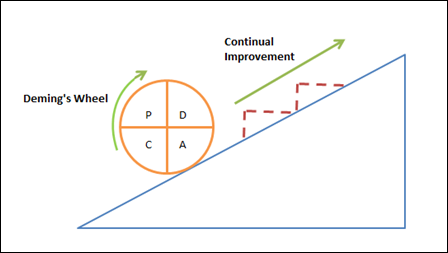PDCA cycle is one of the simplest and the easiest management approaches for process control and continuous improvement.
PDCA – stands for Plan – Do – Check – Act.
It is also called Deming’s cycle or Shewhart cycle.
Sometimes it is also called a PDSA cycle: Plan-do-Study-Act.
It is used for a new product or concept development, problem solving, project implementation and many other fields.
Origin of the PDCA Cycle
PDCA cycle was originally proposed by Shewhart in 1950s in a different format. When he proposed, he had only three components in the cycle. They are: Specification – Production – Inspection. He defined in keeping in mind the Production and manufacturing processes that he worked on for improvement. It was used by various people for various purposes since then.
The famous Edward Deming often advocated for this in his speeches and books. Only in later 1950s it took a new life in the form of PDCA cycle. Deming often referred PDCA as Shewhart’s cycle. But because of the promotions done by Deming, it came to be known as Deming’s cycle. Deming made a small change to it and called it PDSA, as he wanted to give more emphasis on ‘Analysis’ rather than just ‘Inspection’ or ‘Checking’.
Applications of the PDCA Cycle
- PDCA cycle is mainly used in software field for Software development lifecycle.
- It is used in manufacturing and Service industries for new product development.
- It also finds its place in Project Management of any nature.
- Areas like Change Management also use PDCA cycle for their implementation.
What does a PDCA cycle do?
PDCA cycle advocated by Deming finds an important place in continual improvement. It helps a process to improve its performance on a staged and steady manner. The below diagram is a very popular one amongst Quality professionals and management text books.
Let us now see, the activities in each stage of a PDCA Cycle.
Plan:
- Establish the objectives and goals of the task to be improved or developed.
- Describe the task in detail with clear specifications
- Develop a team that will be a part of the PDCA and set the deadlines
- Note down the data to be used, resources that will be needed, cost expected, risks and mitigating steps, manpower required, support needed from management.
- Draw an implementation plan with breakdown of each task, owner, expected outcome, operating procedure or guidelines etc.
Do:
- As per the implementation plan, perform all the tasks.
- Keep the stakeholders informed of the progress
- Adhere to the schedule and highlight any significant concerns and variations noted.
Check:
- One the activity is performed, validate whether the outcome is as intended and planned.
- Make a note of all variations, defects, best practices, pain areas and challenges faced
- Identify the root causes for the problems
Act:
- Correct the defects and make it comply to the specifications
- Identify the preventive actions for all the root causes identified
- Implement the preventive actions and check whether the outcome is as expected.
- Repeat the steps Do-Check-Act until all of the objectives are met to the satisfaction of the stakeholders.
Thus the PDCA cycle will help in improving the performance of a process stage by stage in a steady and levelled manner.

